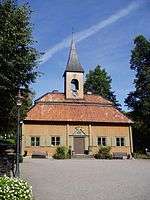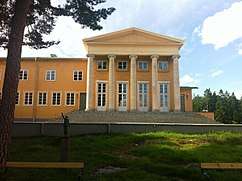Sigtuna
| Sigtuna | ||
|---|---|---|
 Stora gatan, the old main street | ||
| ||
 Sigtuna  Sigtuna | ||
| Coordinates: 59°37′N 17°43′E / 59.617°N 17.717°ECoordinates: 59°37′N 17°43′E / 59.617°N 17.717°E | ||
| Country | Sweden | |
| Province | Uppland | |
| County | Stockholm County | |
| Municipality | Sigtuna Municipality | |
| Area[1] | ||
| • Total | 4.57 km2 (1.76 sq mi) | |
| Population (31 December 2010)[1] | ||
| • Total | 8,444 | |
| • Density | 1,849/km2 (4,790/sq mi) | |
| Time zone | UTC+1 (CET) | |
| • Summer (DST) | UTC+2 (CEST) | |
| Website | Official website | |

Sigtuna is a locality situated in Sigtuna Municipality, Stockholm County, Sweden with 8,444 inhabitants in 2010.[1] It is the namesake of the municipality even though the seat is in Märsta. Sigtuna is, despite its small population, for historical reasons often still referred to as a stad. Statistics Sweden, however, only counts localities with more than 10,000 inhabitants as stads (a designation that encompasses both towns and cities).
Although less significant today, Sigtuna has an important place in Sweden's early history. It is the oldest town in Sweden, having been founded in 980. The history of Sigtuna before the 11th century, as described in the Norse sagas and other early medieval sources, can be found in the article Old Sigtuna.
Sigtuna has a picturesque medieval town centre with restaurants, cafes and small shops. The old church ruins, runic stones and Stora gatan, the old main street, are popular attractions for tourists especially in the summertime. The small streets with the low built wooden houses lead up to several handicrafts shops and the old tiny town hall, Sigtuna Rådhus. There are restaurants and a hotel (Stadshotellet) in the town centre.
Geography
Sigtuna is situated at the bay Skarven, stretching around Upplands-Bro and a part of Lake Mälaren.
History

Sigtuna was founded on what was then the shore of Lake Mälaren just over 1,000 years ago. It took its name from an ancient royal estate (see Uppsala öd) several kilometers to the west (see Fornsigtuna). Various sources claim King Eric the Victorious as founder while others claim King Olof Skötkonung.
It operated as a royal and commercial centre for some 250 years, and was one of the most important cities of Sweden. During a brief period at the end of the 10th and beginning of the 11th century, Sweden's first coins were minted here. St. Mary's Church, built in the 13th century by the Dominican order as a monastery church, still remains largely intact. The Dominican monastery played an important role in the Swedish Middle Ages and produced many important Church officials. Among them, many Swedish archbishops. Many church and monastery ruins still stand, and the old town structure has not been remodeled, as happened in many Swedish cities during the 19th and 20th centuries.
In 1187 Sigtuna was attacked and pillaged by raiders from across the Baltic Sea, possibly Karelians,[2][3] Curonian and/or Estonian (Oeselian) raiders.[4][5] Archaeological excavations have not verified the traditions of destruction of the town. Normal life in Sigtuna continued until town started to slowly lose its importance during 13th century due to navigability problems caused by post-glacial rebound.[5]
The current coat of arms can be traced to the town's first known seal, dating from 1311. According to a legend (possibly inspired by the town arms) Sigtuna was once the Royal seat, but this can not be confirmed. The crown may also symbolize the large royal mint which was located in the town. Since 1971 the coat of arms has been valid for the much larger Sigtuna Municipality.
In the late 19th century, it still only hosted about 600 people, and was the smallest town in Sweden. The town remained insignificant until the second half of the 20th century. Much of the population growth can be related to Arlanda Airport, situated some 10 km from Sigtuna.
Gallery
History
 Sigtuna as it looked around 1700. Engraving from Suecia antiqua et hodierna.
Sigtuna as it looked around 1700. Engraving from Suecia antiqua et hodierna.
Main sights
_(66004171).jpg) Sigtuna old town hall in early winter
Sigtuna old town hall in early winter- St. Mary's Church (Mariakyrkan)
 St Olof's Church ruin
St Olof's Church ruin Sigtuna vicarage and St Per's Church ruin
Sigtuna vicarage and St Per's Church ruin St Lars' Church ruin
St Lars' Church ruin Sigtuna Stadshotell, the traditional town hotel overlooking lake Mälaren
Sigtuna Stadshotell, the traditional town hotel overlooking lake Mälaren Sigtuna Museum
Sigtuna Museum Sigtunaskolan Humanistiska Läroverket (boarding school)
Sigtunaskolan Humanistiska Läroverket (boarding school) The Sigtuna foundation (Sigtunastiftelsen), a private cultural foundation established in 1917
The Sigtuna foundation (Sigtunastiftelsen), a private cultural foundation established in 1917 The sundeck by lake
The sundeck by lake
See also
- Sigtunaskolan Humanistiska Läroverket, a famous boarding school.
- Luodian is a replica of Sigtuna located in Shanghai
Notes
- 1 2 3 "Tätorternas landareal, folkmängd och invånare per km2 2005 och 2010" (in Swedish). Statistics Sweden. 14 December 2011. Archived from the original on 10 January 2012. Retrieved 10 January 2012.
- ↑ fi:Sigtunan tuho
- ↑ Sandén, Börje. "Sigtunas förhärjning 1187". www.ukforsk.se. Archived from the original on 4 March 2016. Retrieved 27 April 2018.
- ↑ "Till frågan om Sigtunas combustering år 1187" "Archived copy" (PDF). Archived (PDF) from the original on 2012-04-26. Retrieved 2011-12-25.
- 1 2 Enn Tarvel (2007). Sigtuna hukkumine. Archived 2017-10-11 at the Wayback Machine. Haridus, 2007 (7-8), p 38–41
References
- (in Swedish) "Sigtuna" from Nordisk familjebok
External links
| Wikimedia Commons has media related to Sigtuna. |
| Wikivoyage has a travel guide for Sigtuna. |
- Sigtuna Municipality - Official site
